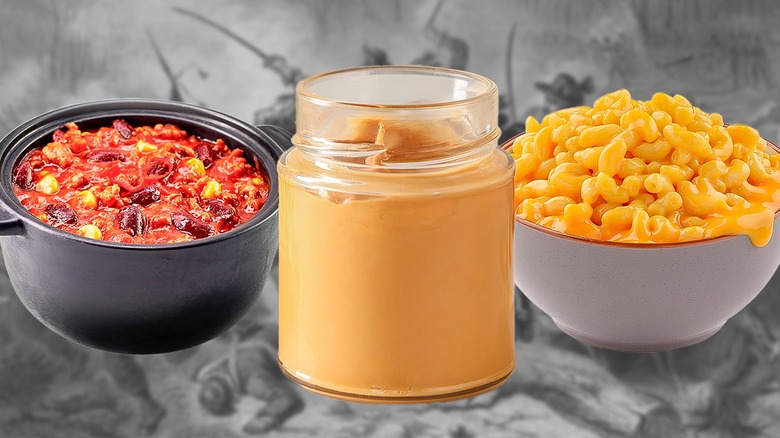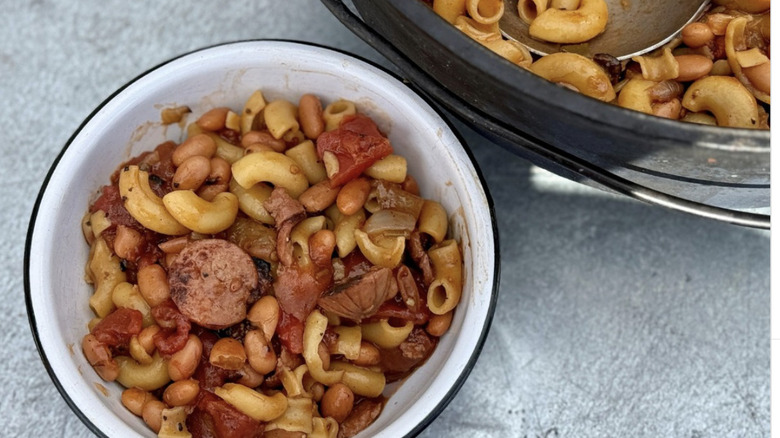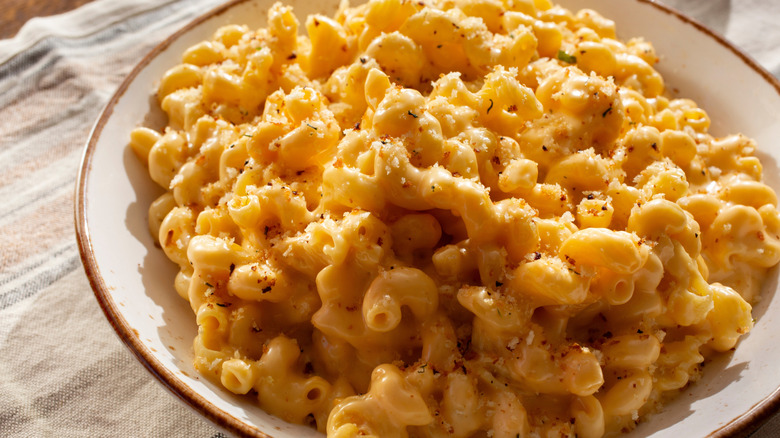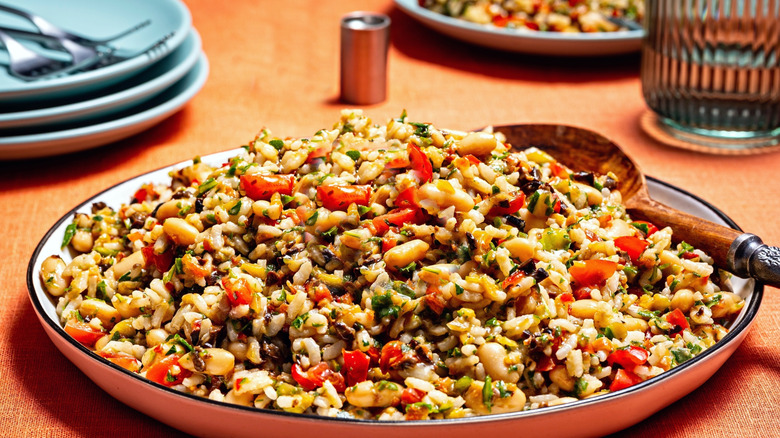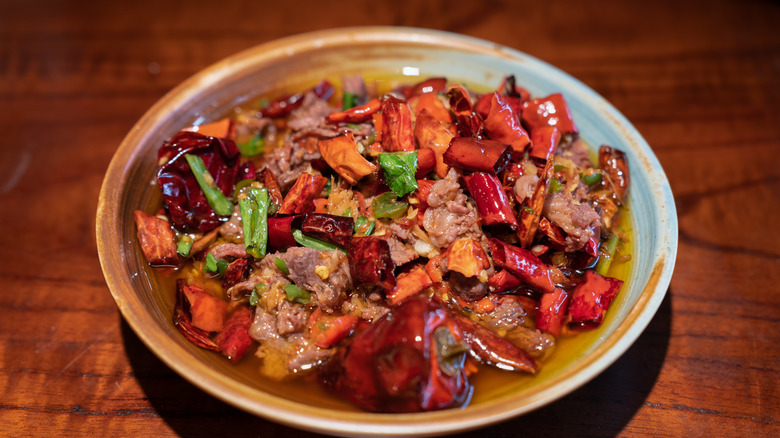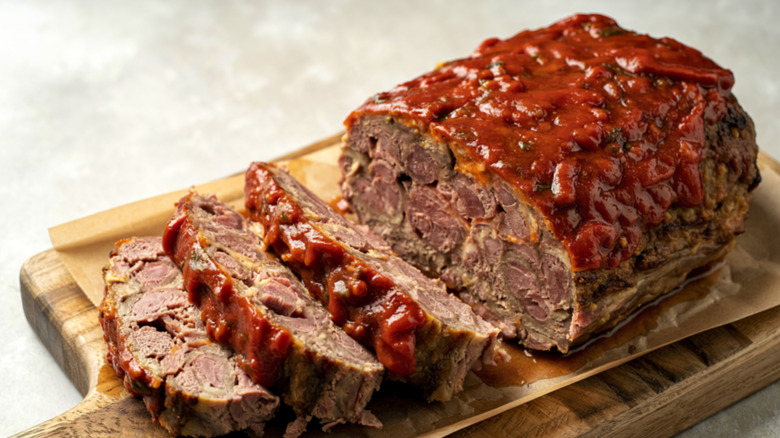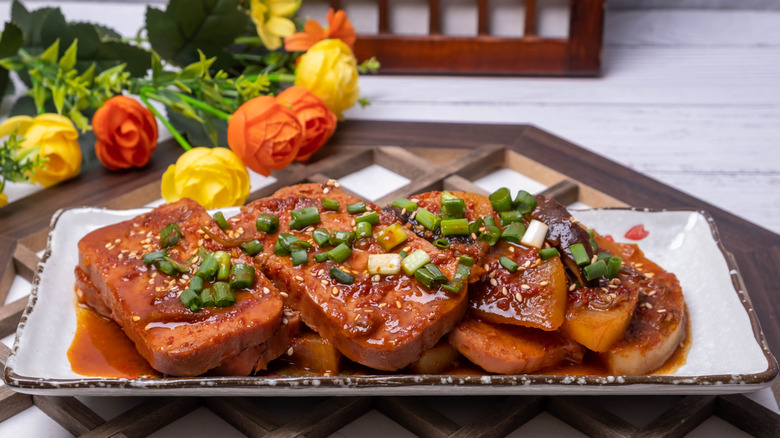8 American Dishes Invented Out Of Necessity
Picture a steaming bowl of Texas red chili, the crunch of freshly made fry bread, and the familiar creamy goodness of a Twinkie. It hardly seems possible that so many homegrown American classic comfort foods were created out of necessity rather than desire, but for all of these, it's true. Throughout American history, there have been many occasions when food was scarce, prompting industrious individuals to be creative with what food was available. From the earliest days of the United States, when the Wampanoag tribes foraged vegetables and hunted venison to create the light and refreshing dish that we know as succotash, to the hardships of World War 2, many of our favorite dishes came about as the result of dire circumstances.
Not all the dishes on this list evoke feelings of happy nostalgia. While diving into a bowl of macaroni and cheese or indulging in a second slice of Mom's meatloaf may leave you feeling gloriously satiated, some of these items are less popular. For every person who loves Spam, others would rather never see another slice again — a feeling echoed by the G.I.s who were forced to eat it for three meals a day during the war, and the popularity of a Hoover stew is taking a nose dive in this era of fine dining. Regardless, these eight American dishes created out of necessity are symbols of American perseverance in the face of hardships, and we hope they remain in vogue for many years to come.
1. Hoover stew
Hoover Stew was named after President Hoover, who was in office during the Great Depression. The Great Depression of 1929 was a period of widespread poverty that affected the United States and was felt globally. This cataclysmic event was triggered by the Wall Street stock market crash and continued for nearly a decade. Following the crash of America's stock market, panic caused people to withdraw savings from the banks. As the national reserves became depleted, banks withdrew funding, and were unable to meet the public's demand for cash — in short, the entire economy collapsed, millions of jobs were lost, and poverty became endemic.
With limited funds, families were forced to scrounge together and rely on their creativity to find ways to feed themselves, hence the creation of Hoover stew. This dish is very similar to hobo stew, and both are made using a mixture of readily available ingredients. The key difference is that hobo Stew relies more heavily on foraged ingredients, while Hoover stew targets uses cupboard and canned goods.
Typically, Hoover stew consists of canned or boxed hot dogs, macaroni, tomatoes, and corn, but thanks to the nature of necessity, these items can be omitted, added to, or swapped out for something else, depending on what's available. Simply boil the ingredients together, cooking the macaroni until it's al dente. If you want to make Hoover stew but are worried it may be a little bland, consider adding flavor through spices, herbs, hearty broths, or acidic ingredients like vinegar or lemon. Adding some fresh vegetables like spinach or kale is a great way to boost the healthiness of the meal.
2. Mac 'n' Cheese
Mac 'n' Cheese is such an American classic that it is hard to think of a time when it wasn't around, and perhaps harder to imagine it as anything other than the ultimate comfort food — so it may be surprising to learn that anything so cheesily decadent was created out of necessity.
The concept of pasta and cheese is an old one, with the earliest recorded reference to a similar dish dating back to 1967 in Northern Europe. A hybrid form of this gluttonous delight arrived in the U.S. in the early 1800s when President Thomas Jefferson served a dish called macaroni pie to his guests at a state dinner following a trip to Europe. However, the dish only became the mac 'n' cheese we know today after its reinvention by Kraft during the Great Depression.
In 1937, Kraft released its infamous blue box of ready-made macaroni and cheese, which could feed an entire family for just 19 cents. So cheap and so tasty was the product that Kraft sold 8 million boxes in the first year, which soared to 80 million by 1943. Kraft still sells its Mac 'n' Cheese today, but the humble dish has reached new levels of popularity and has been upgraded, altered, and served in the best restaurants all over the world. Tasting Table looked at 10 decadent mac and cheese recipes, which include the scrumptious shrimp mac 'n' cheese and the even more comforting butternut mac and cheese.
3. Succotash
Succotash was created by the indigenous people who lived in North America as far back as the 13th century. Succotash, a word that comes from the Narragansett word for boiled kernels of corn, msickquatash, is a beloved traditional American dish made entirely with food that could be hunted or foraged from the land.
The earliest oral records of succotash state that it was created by the Wampanoag tribe, who lived along the east coast of the United States, from Weymouth to Rhode Island. The Wampanoag were seasonal hunters and foragers, moving between the forests and the ocean depending on the seasons, so the food they ate had to be caught or found, rather than grown. The original native succotashes were made with corn and beans, adding in whatever fish, meat, vegetables, herbs, or roots could be found. With the arrival of colonists, the foraged foodstuffs were gradually replaced with farmed animals and vegetables such as pork and potatoes.
Today's succotash recipes remain the same as the original at their core, with a base of corn and beans, with a variety of added ingredients. This classic succotash recipe uses onions, tomatoes, garlic, paprika, and sage, and adds green beans in addition to the more traditional lima beans. Succotash is often eaten as part of a Thanksgiving meal, especially in the Eastern United States, but it's considered a summer dish, similar to a salad, and is enjoyed alongside any meat or fish.
4. Chili con carne
Chili, or chili con carne, is an American staple eaten in nearly every home. There are untold numbers of variations on this dish that, at its simplest, is a stew made from meat, beans, and chili spice. The exact recipe differs by region and by chef, with many families claiming to have a secret chili recipe handed down through generations.
The first chilis originated in the American Southwest — cowboy country. They were made from a mix of dried meat, suet, and chili peppers (with the chilis serving to keep flies away). This dehydrated meat mixture could last for weeks, and a meal could be prepared by taking a chunk and mixing it with water to create a stew. This method of preserving and carrying a nutritious meal was essential for the cowboys, who frequently spent weeks or months out in the countryside.
Chili was later popularized by a group of women who became known as the Chili Queens of San Antonio. These women fed large groups of travelers, soldiers, and cowboys who came through the town. The rule of the chili queens lasted for 60 years, and during this time, chili morphed from an easy-to-rehydrate mixture of fat and dried meat to the sumptuous meal that it is today. As the dish spread across the continent, many different varieties of chili emerged. For example, Texas red chili is known for using ancho chili, Tex-Mex typically includes beans, and you can find chili made with chicken, vegetarian chili, or Mexican-style chili with the addition of chocolate.
5. Meatloaf
Meatloaf, beloved by families throughout America, is a dish made from ground beef with onion and seasonings, held together with breadcrumbs and formed into a loaf. It's then baked and sliced like bread. Meatloaf is a tasty, inexpensive dish and a symbol of American resourcefulness, but although it rose to fame during the Great Depression, Meatloaf in some form has been a staple since ancient times.
A dish made of minced meat, wine-soaked bread, and dried fruits can be traced back to the Ancient Romans, around the 1st century AD, and variations on the dish appear in recipe books throughout Europe for the following 1000 years. Meatloaf, in its closest form, arrived in the United States courtesy of Dutch immigrants who brought a similar dish called Scrapple to Pennsylvania.
Meatloaf, as we know it, was created in the Depression Era. During this period of extreme poverty and enforced frugality, inventive homemakers devised creative ways to stretch their meat rations, with help from the still-newly available meat grinder. The ground meat was combined with other ingredients, to bulk it up, such as flour, oats, ketchup, condensed soup, and ketchup, the latter two adding taste to an otherwise bland dish — and thus Meatloaf, as we know it today, was born. The popularity of Meatloaf continues in part because it's seen as a classic American dish, but also for its affordability, convenience, and ease of preparation.
6. Twinkies
Twinkies, in their current form, are another wartime invention, with a filling so delicious it seems hard to believe that it was created through necessity. Call it what you will, snack or cake, but Twinkies are an iconic American food. These cream-filled, sponge-based bites of gloriousness are drenched in nostalgia. For nearly 100 years, kids have been eating them from their lunchboxes and snacking on them after school. Twinkies have become synonymous with America and certainly hold their own in the hall of food fame.
Twinkies, with their distinctive cream-filled centers, were introduced in 1930 by Jimmy Dewar, an industrious baker working for the Continental Baking Company in Illinois. Jimmy observed that a line of shortcakes sat idle when their typical filling of strawberries was out of season. Seeking to create a cake that could be produced all year round, Dewar came up with the idea of filling the oblong-shaped sponge cases with banana-flavored cream and calling them Twinkies. The cakes were a hit, but shortly afterward, the Second World War began, and the bananas for his banana-cream filling were unavailable. Not one to back down from a challenge, he changed the filling to a vanilla cream. This cake, as we know it, remains the same to this day. Interestingly, the parent company Hostess occasionally produces a banana cream-filled variant, perhaps in homage to Twinkies' original incarnation.
7. Spam
Another food item created during the Great Depression and still available today is the love-it-or-hate-it protein product Spam. With the name being a portmanteau of spiced ham, it was invented in 1937 by Jay Hormel, of Hormel Foods, initially as a way of making something useful out of leftover pork shoulder scraps. Hormel also recognized the need for a cheap protein during the frugal times of the Great Depression, and the product was loved by housewives searching for an affordable and acceptable alternative to fresh meat.
However, it wasn't until World War 2 that Spam grew in fame and distribution. As a food item, Spam was notable for its long shelf life and transportability, which enabled it to be shipped to military forces abroad. It was once cited as a wartime delicacy by Margaret Thatcher, but this sentiment wasn't echoed by the soldiers who were forced to eat Spam daily, for breakfast, lunch, and dinner. Spam became a symbol of American endurance and resistance, and was widely eaten by our military groups and the civilians who remained at home.
Spam is made from chopped pork shoulder and ham, seasoned with salt, and combined with potato starch and sodium nitrite before being heated and canned. It's still the subject of love and ire today, with Hormel claiming that 12.8 cans of Spam are eaten every second, across 50 different countries. Spam is available in 11 different varieties, from healthier, low-sodium versions to maple, smoked chili, and spiced flavors. Due to its immense popularity in Asia, various Asian-style recipes, such as Korean, teriyaki, and gochujang, are also available. If you're curious, take a look at our taste test of every Spam flavor.
8. Fry bread
Fry bread, the Navajo dish made from flour, lard, salt, and water, has a creation story mired in violence and regret — despite this, the bread remains popular throughout the United States today. Created with just four basic ingredients, today's fry bread is often enhanced with the addition of baking soda and milk to achieve a lighter and slightly creamier texture. The dough is fried in oil and can be eaten alone or alongside chili, stew, or even topped with jam or honey for a sweeter treat. While many consider fry bread a comfort food, for others, the consumption of a food that is a symbol of persecution raises an ethical dilemma.
Fry bread was created during a dark time in American history, when the Navajo people were forced from their homelands in an event that has since been named the Long Walk. This happened between 1863 and 1866, after an extended period of oppression by the U.S. military in which sacred Navajo land, villages, and animals were burned and slaughtered. As a result of extreme brutality and enforced starvation, more than 10,000 Navajo people were forced to walk between 250 and 450 miles to the Bosque Redondo Reservation at Fort Sumner, in current-day New Mexico. After their arrival, the Navajo were essentially imprisoned within the camps and provided only with meager food supplies. The Navajo created Fry bread from the flour, oil, and water that was part of their rations, and as a means for the Navajo people to sustain themselves during a time of scarcity.
